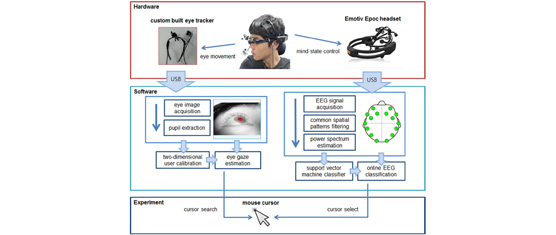
Abstract
This paper describes a low-cost noninvasive brain-computer interface (BCI) hybridized with eye tracking. It also discusses its feasibility through a Fitts’ law-based quantitative evaluation method. Noninvasive BCI has recently received a lot of attention. To bring the BCI applications into real life, user-friendly and easily portable devices need to be provided. In this work, as an approach to realize a real-world BCI, electroencephalograph (EEG)-based BCI combined with eye tracking is investigated. The two interfaces can be complementary to attain improved performance. Especially to consider public availability, a low-cost interface device is intentionally used for test. A low-cost commercial EEG recording device is integrated with an inexpensive custom-built eye tracker. The developed hybrid interface is evaluated through target pointing and selection experiments. Eye movement is interpreted as cursor movement and noninvasive BCI selects a cursor point with two selection confirmation schemes. Using Fitts’ law, the proposed interface scheme is compared with other interface schemes such as mouse, eye tracking with dwell time, and eye tracking with keyboard. In addition, the proposed hybrid BCI system is discussed with respect to a practical interface scheme. Although further advancement is required, the proposed hybrid BCI system has the potential to be practically useful in a natural and intuitive manner.

